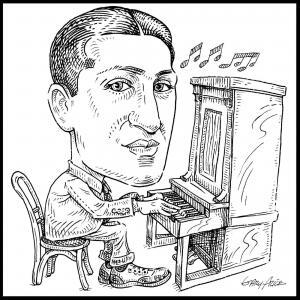 George Gershwin was born September 26, 1898 in Brooklyn, New York. Gershwin, whose name at birth was Jacob Gershwine, had a typically rough-and-tumble childhood, roughhousing and roller-skating on the streets of New York City. When a piano was brought into the household, George’s older brother Ira was chosen to take lessons. To the surprise of his parents and brother, George moved in on the piano and monopolized it. (Ira’s interests proved to be more literary; his early immersion in W. S. Gilbert’s Bab Ballads inspired him to attempt lyric-writing.)
George Gershwin was born September 26, 1898 in Brooklyn, New York. Gershwin, whose name at birth was Jacob Gershwine, had a typically rough-and-tumble childhood, roughhousing and roller-skating on the streets of New York City. When a piano was brought into the household, George’s older brother Ira was chosen to take lessons. To the surprise of his parents and brother, George moved in on the piano and monopolized it. (Ira’s interests proved to be more literary; his early immersion in W. S. Gilbert’s Bab Ballads inspired him to attempt lyric-writing.)
George was largely self-taught as a pianist, but he studied with a series of teachers, beginning with Charles Hambitzer, who instructed him in conventional piano technique and music theory—and introduced him to the classical repertoire. For the rest of his life, Gershwin navigated between the worlds of classical and popular music, finding acceptance and success in both.
“Swanee” (written in 1919 with lyricist Irving Caesar) became George’s first big song hit after Al Jolson heard him playing it at a party and decided to interpolate it into Sinbad. George collaborated with his brother Ira on Broadway shows beginning with Lady Be Good in 1924. That same year he composed Rhapsody in Blue, orchestrated by Ferde Grofé and premiered by Paul Whiteman’s Orchestra at Aeolian Hall. Broadway hits (full of now-classic popular tunes) and concert pieces followed. He impressed and befriended Maurice Ravel; the two influenced each other’s work.
Gershwin’s magnum opus was Porgy and Bess, which may be considered both a Broadway musical and Grand Opera; it’s both jazz and classical. (To finance the production, George took on a network radio gig, Music by Gershwin, sponsored by Feen-a-mint.) After Porgy and Bess, George and Ira moved to Hollywood to write film scores. Early in 1937, George began to suffer severe headaches and experience coordination problems. While writing the music for The Goldwyn Follies, he fell into a coma resulting from an undiagnosed brain tumor. He died during emergency surgery on July 11, 1937.
While he wasn’t strictly a jazz musician, George Gershwin’s compositions rely on the irresistible harmonies and rhythms of ragtime and jazz. As such, his tunes are permanent and indispensable jazz standards.
Further Reading: 1920: The Year Broadway Learned To Syncopate
Andy Senior is the Publisher of The Syncopated Times and on occasion he still gets out a Radiola! podcast for our listening pleasure.




















